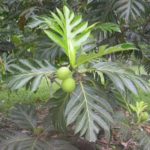
Okra plants (Abelmoschus esculentus): Synonym: Hibiscus esculentus
Common names
Dongo, Lonto (Kongo), Dongo dongo, Molenda (Lingala), Gombo (Fr.)
Description
An erect annual herb usually 1 – 2 m. high. Leaves are 3 to 5 lobed, spirally arranged and may be up to 50 cm in diameter with a petiole of similar length. The solitary yellow flowers have a purple centre and arise from the leaf axils. Fruit is produced during the rainy season and is a cylindrical capsule 5 – 35 cm long and 1 – 5 cm in diameter.
Ecology
In Kongo Central province, DRC, a few okra plants are grown near the home, often with other vegetables. The plants prefer soils which are well-drained, fertile, with adequate organic matter but can also grow on soils of moderate fertility. It is also found growing in fallow land and on the sites of old villages.
Propagation
Seed is normally used and is best stored in the fruits until required. Soak seeds for 24 hours before planting, discarding any that float. Sow in deeply cultivated land and, if grown commercially, plant rows 60 – 80 cm apart allowing 15 – 20 cm between plants.
Management
Mulching the crop is beneficial as it provides a cool microclimate for the young plants and suppresses weed growth. The terminal bud is sometimes removed to encourage branching. The fruit of okra plants should be harvested while they are still crisp and can be snapped easily. 4 – 6 fruits are produced per plant over 30 – 40 days. The harvesting of young fruits encourages vegetative growth prolonging the harvest. Nematode damage is best controlled by crop rotation, avoiding growing on land where okra, cotton, roselle or kenaf have recently been grown, and by applying high amounts of organic manure.
Uses
In Kongo Central province the young immature plant fruits (Gombo) are either boiled or fried, being particularly liked in soups and stews because of their stickiness. They may also be dried and powdered and used for flavouring. Leaves and young shoots are also eaten, both fresh and fried, either alone or with the fruits and flowers and are a common market vegetable. Eating the plant is known to prevent goitre. The roasted seed can be used as a substitute for coffee.
References
Gillet 1927, Renier 1948, Hauman 1963, Daeleman & Pauwels 1983, Tindall 1983, Siemonsma & Kasem Piluek 1993, Burkill 1997, Schippers 2002, Siemonsma & Kouamé 2004, SEPASAL (Accessed 6.12. 2013)
___________________________________________________________________________________________________________
Text and photo at this article © Paul Letham. The author’s professional background and contact information can be found here.
.




